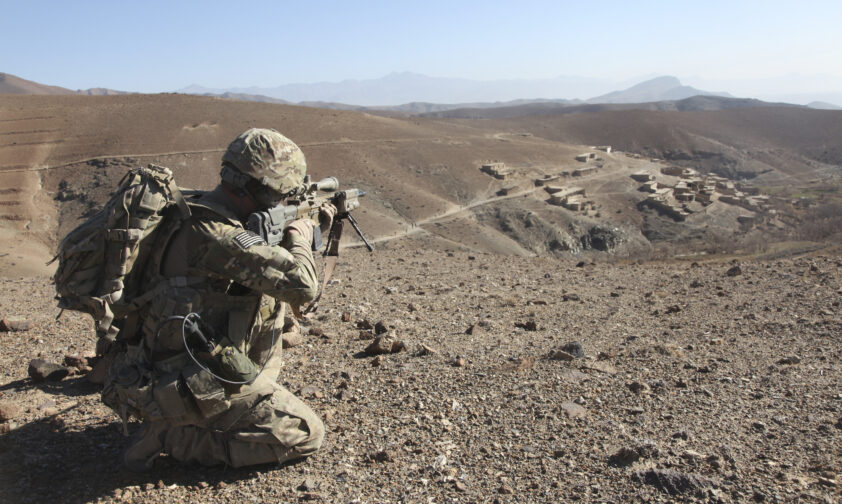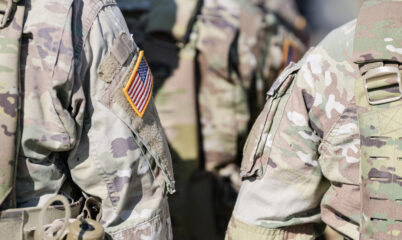
Here’s a timeline of America’s 20 years of war in Afghanistan and Iraq
Twenty years ago in October, the United States began combat operations in Afghanistan. At that time, the U.S. was justified in beginning military engagement against enemies who had planned and executed the attacks of September 11, 2001, or had harbored those enemies.
But not long after operations started, the war in Afghanistan took a turn away from its original objectives toward vague nation-building efforts.
At the same time, the U.S. went to war in Iraq under similarly hazy notions of combating terrorism and establishing democracy around the world.
Through the years, endless war has become a way of life for the U.S.
Four presidents have overseen military engagements that have resulted in thousands of lives lost and trillions of dollars spent. Meanwhile, Congress has ignored its responsibility to vote on decisions of war and peace.
After more than two decades of constant war, U.S. foreign policy may finally be heading in a better direction, but there is still a long way to go to ensure our country is safe and those who perpetuated the disastrous wars are held accountable.
Here is a look back at how that war and military engagements in Iraq, Syria, and elsewhere have unfolded.
September 14, 2001: Congress passes a resolution, signed by President George W. Bush four days later, to provide the Authorization for Use of Military Force in response to the September 11 attacks.
The resolution authorizes the president “to use all necessary and appropriate force against those nations, organizations, or persons he determines planned, authorized, committed, or aided the terrorist attacks that occurred on September 11, 2001, or harbored such organizations or persons, in order to prevent any future acts of international terrorism against the United States by such nations, organizations or persons.”
October 7, 2001: Operation Enduring Freedom officially begins with a bombing campaign by U.S. forces against Taliban targets. Less than two weeks later, ground operations begin.
January 2002: After just a few months, the Taliban government collapses, an interim government is established, and Osama bin Laden is on the run.
April 17, 2002: Bush calls for rebuilding Afghanistan so it is “free from this evil and is a better place in which to live.”
October 11, 2002: Congress passes the AUMF for Iraq, which is signed by Bush four days later.
The authorization allows the president to use the armed forces of the United States “as he determines to be necessary and appropriate in order to defend the national security of the United States against the continuing threat posed by Iraq; and enforce all relevant United Nations Security Council resolutions regarding Iraq.”
March 19-20, 2003: Air and ground combat operations begin in Iraq.
May 1, 2003: Less than two months after starting, Bush announces the end of major combat operations in Iraq. A troop presence continues in the country.
November 15, 2005: By a margin of 79-19, the Senate approves an amendment directing that “calendar year 2006 should be a period of significant transition to full Iraqi sovereignty … creating the conditions for the phased redeployment of United States forces [out of] Iraq,” and calling on the administration to “explain to Congress and the American people its strategy for the successful completion of the mission in Iraq.”
July 14, 2008: After five years of combat in Iraq, then-Democratic presidential candidate Sen. Barack Obama writes “My Plan for Iraq,” stating “I opposed the war in Iraq before it began, and would end it as president.” He says “on my first day in office, I would give the military a new mission: ending this war.”
December 14, 2008: In the waning days of his presidency, Bush signs the Iraq Status of Forces Agreement, a revised security deal with the Iraqi government that calls for “all American troops” to be withdrawn by the end of 2011.
February 17, 2009: Weeks after his inauguration, President Obama authorizes an increase of 17,000 in U.S. troop levels in Afghanistan. Prior to the Obama “surge,” there were 36,000 American troops and 32,000 NATO troops in Afghanistan.
December 1, 2009: Obama announces his decision to increase U.S. troop levels in Afghanistan by 30,000, with withdrawal of those reinforcements to begin 18 months later.
The increase is supported by General Stanley McChrystal, the top military commander in Afghanistan, who had warned the war would likely be lost without such a troop increase.
At the same time, administration officials seek a corresponding increase in NATO troop levels in the country.
March 19, 2011: A NATO-led coalition, including the U.S., begins an air campaign in Libya against the government of Muammar Gaddafi.
Initially conceived to prevent civilian deaths, the campaign ends in October with the killing of rebels and Gaddafi’s overthrow. The country is soon mired in civil war. Congress never debates or votes to authorize U.S. involvement in this seven-month intervention.
May 2, 2011: U.S. forces kill Osama bin Laden in Pakistan.
September 30, 2011: Al-Qaida leaders Anwar al-Awlaki and Samir Khan ― both American citizens ― are killed in an American drone strike in Yemen.
The attack intended to kill al-Awlaki, who was authorized as a U.S. target in 2010. Al-Awlaki’s son and daughter ― also U.S. citizens ― would later be killed in U.S. strikes in Yemen. The Obama administration claims authority for this act under the 2001 AUMF.
October 21, 2011: Obama declares all U.S. combat troops will withdraw from Iraq by the end of the year, and “America’s war in Iraq will be over.” Most U.S. troops ultimately withdrew by December of that year, leaving fewer than 200 behind.
May 23, 2013: Obama delivers an address at the National Defense University, stating the “AUMF is now nearly 12 years old. The Afghan war is coming to an end. Core al-Qaida is a shell of its former self. … So I look forward to engaging Congress and the American people in efforts to refine, and ultimately repeal, the AUMF’s mandate.”
May 22, 2014: A group of Democratic leaders in the House and Senate announce the introduction of legislation to repeal the Iraq AUMF of 2002. This effort ultimately fails.
June 16, 2014: Obama announces 275 troops will be sent to Iraq to provide security for the U.S. Embassy. That same week, he announces the creation of “joint operations centers” in Iraq, to coordinate planning to confront the ISIS threat.
September 12, 2014: A senior official of the Obama administration identifies the 2001 AUMF as providing authority to retaliate against ISIS. The official argues that the 2002 AUMF also grants such authority, despite ISIS not existing in 2001 or 2002.
September 22, 2014: Obama orders airstrikes against ISIS in Syria. Earlier that month, an administration official told reporters this action was authorized by the 2001 AUMF, as ISIS was a part of al-Qaida.
December 13, 2014: Sen. Robert Menendez introduces S.J.Res. 47, an Authorization for the Use of Military Force against the Islamic State of Iraq and the Levant (commonly known as “ISIL” or “ISIS”).
This authorization allows U.S. forces to engagement ISIS or associated persons or forces for three years ― with limits on use of ground troops. The resolution follows a Senate hearing on the AUMF, and it is subsequently wins committee approval.
February 11, 2015: Obama submits a request to Congress for a new AUMF against ISIS. He simultaneously endorses repeal of the 2001 AUMF.
Leaders in Congress decline to act on the request, citing concerns it could place “constraints” on military commanders. By now there are 4,500 U.S. troops in Iraq, up from 200 at the end of 2011.
March 26, 2015: A coalition led by Saudi Arabia launches strikes against Houthi rebels in neighboring Yemen.
The move is seen as an attempt by Saudi Arabia and its allies to counter growing Iranian influence in Yemen. The U.S. offers “logistical and intelligence support” for the Saudi-led action. Within the next year, that support reportedly grows to include munitions and airborne tankers. This U.S. presence occurs without authorization by Congress.
October 25, 2016: Republican presidential candidate Donald Trump warns that enforcing no-fly zones in Syria could lead the United States into conflict with Russia and Iran ― potentially leading to “World War III.” Trump declares that “the first thing we have to do is get rid of ISIS before we start thinking about Syria.”
September 13, 2017: The U.S. Senate defeats a bipartisan push by Sens. Rand Paul and Tim Kaine to repeal the 2001 AUMF. The vote is 61-36. Earlier in 2017, an effort to repeal the same AUMF was derailed by leadership in the House.
April 16, 2018: A bipartisan group of U.S. senators introduces legislation to replace both the 2001 AUMF in response to 9/11 and the 2002 Iraq AUMF with a revised AUMF aimed at al-Qaida, the Taliban, and the Islamic State in Iraq and Syria (ISIS). S.J. Res 59 is not acted on by the Senate.
March 6, 2019: Kaine and Sen. Todd Young introduce S. J. Res. 13 to repeal both the 1991 and 2002 Authorizations for Use of Military Force in Iraq.
April 16, 2019: Trump vetoes S.J.Res. 7, a historic invocation of the War Powers Act by Congress against a current deployment, which passed the Senate by a vote of 54-46, and the House by a vote of 247-175. The measure would have directed the removal of unauthorized U.S. forces from hostilities in Yemen.
July 12, 2019: A National Defense Authorization Act amendment sponsored by Reps. Ro Khanna and Matt Gaetz that would prohibit war with Iran absent congressional authorization, fails in the House, 251-170. However, 27 Republicans voted yes, an unexpectedly high number that showed a growing bipartisan constituency to rein in unauthorized war.
September 16, 2019: Trump declares the U.S. is “locked and loaded,” and prepared to support Saudi Arabia in retaliation for a strike two days earlier on Saudi oil fields.
January 30, 2020: The House votes 236-166 to repeal the 2002 Iraq AUMF.
February 29, 2020: The United States and the Taliban sign an accord intended to reduce violence in Afghanistan and which provides for the withdrawal of all U.S. troops from Afghanistan by April 2021.
September 8, 2020: Trump announces plans to reduce U.S. troop levels in Iraq from 5,200 to 3,500, and to reduce troop levels in Afghanistan from 8,500 to between 4,000 and 5,000 by November.
October 7, 2020: Trump calls for the full withdrawal of American troops from Afghanistan by the end of the year.
January 11, 2021: Rep. Barbara Lee introduces H.R. 256, which would repeal the 2002 Iraq AUMF. The bill acquires over 130 co-sponsors, the most ever for such an effort.
March 3, 2021: Kaine and Young introduce S. J. Res. 10, another 1991 and 2002 AUMF repeal bill, which gains over 40 cosponsors, a sign of increasing support for war powers reform.
April 14, 2021: President Joe Biden announces an extension to the May 1 Afghanistan withdrawal deadline as agreed to with the Taliban during the Trump administration. Troops will begin withdrawing, and military operations will end by September 11, 2021. The full withdrawal deadline would later change to August 31, 2021.
June 17, 2021: H.R. 256 passes the House in a historic 268-161 vote, the first time a 2002 AUMF repeal passed the chamber as a stand-alone bill.
July 20, 2021: Sens. Mike Lee, Chris Murphy, and Bernie Sanders introduce S. 2391, the National Security Powers Act, a comprehensive rewrite of the War Powers Act that would protect congressional prerogatives on decisions about war, arms sales, and national emergencies. Crucially the bill would require all future AUMFs to be limited to specific locations and targeted foes, as well as to sunset after 2 years.
July 26, 2021: Biden announces the “combat” mission is over in Iraq. However, troops remain in the country to “train and assist,” leaving the overall mission relatively unchanged.
August 8, 2021: S.J. Res. 10 is approved by the Senate Foreign Relations Committee
August 15, 2021: As NATO allies, including the United States, are wrapping up their withdrawal, the Afghan Security Forces are easily overrun by the Taliban, who then take over Kabul. Over the next two weeks, thousands of Americans and vulnerable Afghans are airlifted out of the country as the Taliban begins to retake control of the country’s capital.
August 26, 2021: Thirteen U.S. servicemembers are killed and nearly 20 are wounded in a bombing by an ISIS faction outside the Kabul airport. The attack also kills or injures more than 100 Afghan civilians.
August 31, 2021: The United States completes its military evacuation from Afghanistan after a harrowing few weeks. America’s longest war has officially come to an end.
September 13, 2021: The House Foreign Affairs Committee holds the first hearing after the end of the war in Afghanistan. Members largely use the time for partisan bickering and provide little accountability on the war as a whole.
September 23, 2021: Khanna introduces an amendment to end congressionally unauthorized U.S. military logistical and intelligence support for the Saudi-led war in Yemen, which passes the House and is added to its version of the defense authorization bill.
September 30, 2021: Reps. Peter Meijer and Jim McGovern introduce H.R. 4510, the National Security Reforms and Accountability Act, a House companion bill to the National Security Powers Act, tackling war powers reform.
DATE OF PUBLICATION: No military leaders have been held accountable by Congress for their role in 20 years of mismanaged war in Afghanistan. Congress has yet to repeal the 1991, 2001, or 2002 AUMF or reassert its constitutional war powers.
The U.S. military has been engaged around the world for more than 20 years, entangled in efforts that continue to expand into nation-building yet have little to do with vital national interests. It’s time to change the way we approach foreign policy.
Learn more about our efforts to End Endless Wars, and how you can get involved.




